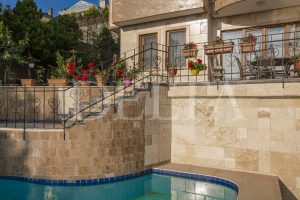Marble and travertine are natural stones that are frequently used in the category of decorative stones and attract attention aesthetically. Both stone types have been preferred in architecture and art throughout history. Let’s look at the common aspects and differences of marble and travertine, which areas of use they are more suitable for and what aesthetic results they provide.

Marble and Travertine Common Aspects
Being Natural Materials: Both marble and travertine are natural stones. They are obtained from limestone deposits under the ground and are extracted raw before being processed. Therefore, both stones are environmentally friendly and natural.
Decorative Use: Both stones are used indoors and outdoors for decorative purposes. While marble is generally preferred indoors as a symbol of luxury and elegance, travertine can be used both indoors and outdoors as it offers a more rustic and natural look.
Durability: Marble and travertine are both durable and long-lasting materials. When properly cared for and used, they can maintain their aesthetic and structural integrity for years.
Variety: Marble and travertine have a wide variety of colours and textures. Marble has a variety of colours and patterns, while travertine has a variety of colour tones and surface textures. This variety offers a wide range of options for designers and architects.

Marble and Travertine Differences
Formation Process and Structure: The formation processes and structures of marble and travertine are quite different. Marble is formed as a result of recrystallisation of limestone under high heat and pressure and has a denser structure. This makes marble ideal for obtaining a smoother and shinier surface. Travertine, on the other hand, is formed by the precipitation of minerals from underground hot springs and has a more porous structure.
Surface Appearance: Marble offers a shiny and smooth surface due to its dense and tight structure. Travertine, on the other hand, provides a more matt and natural appearance thanks to its porous structure. The porous structure of travertine is manifested by the holes on the surface and these holes are usually filled to obtain a smoother surface.
Colour and Pattern: Marble usually has distinctive veined patterns and can be found in various colours such as white, black, grey and green. Travertine is usually in beige, brown and cream tones and has a calmer and homogeneous appearance.
Areas of Use: Marble is generally preferred in interiors such as floor coverings, kitchen countertops, bathroom floors and wall coverings. Its glossy surface and luxurious appearance make marble stand out in interiors. Travertine, on the other hand, can be used both indoors and outdoors. Due to its porous structure, it is especially preferred in areas that require non-slip surfaces such as pool edges, exterior cladding and walkways.
Maintenance and Durability: Marble is resistant to scratches and stains.



